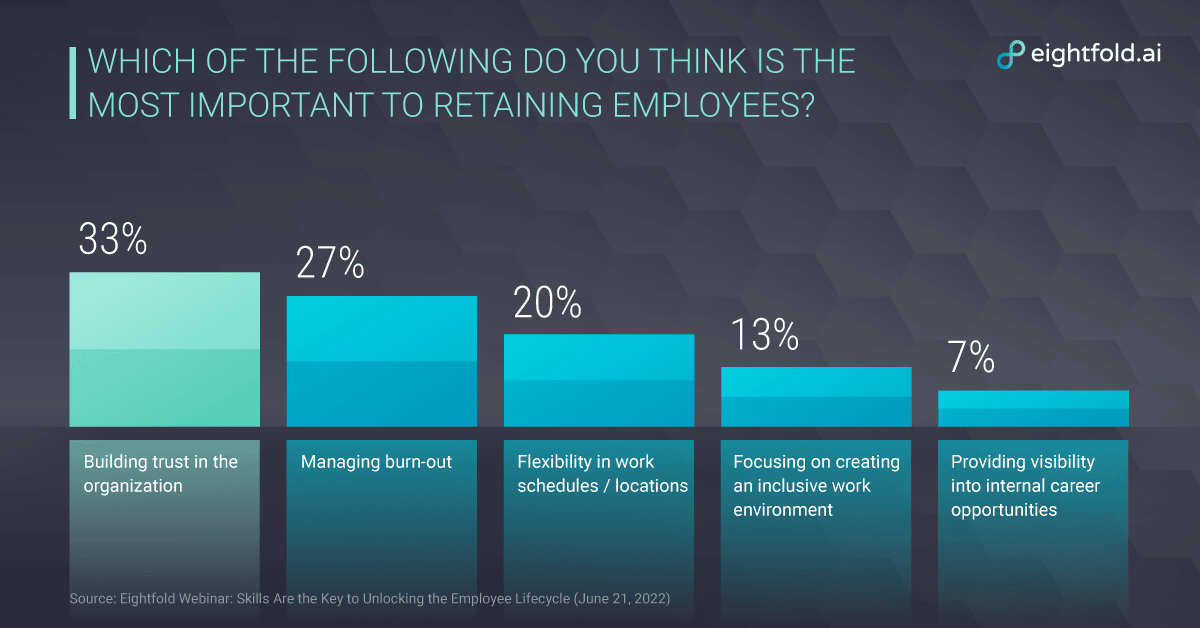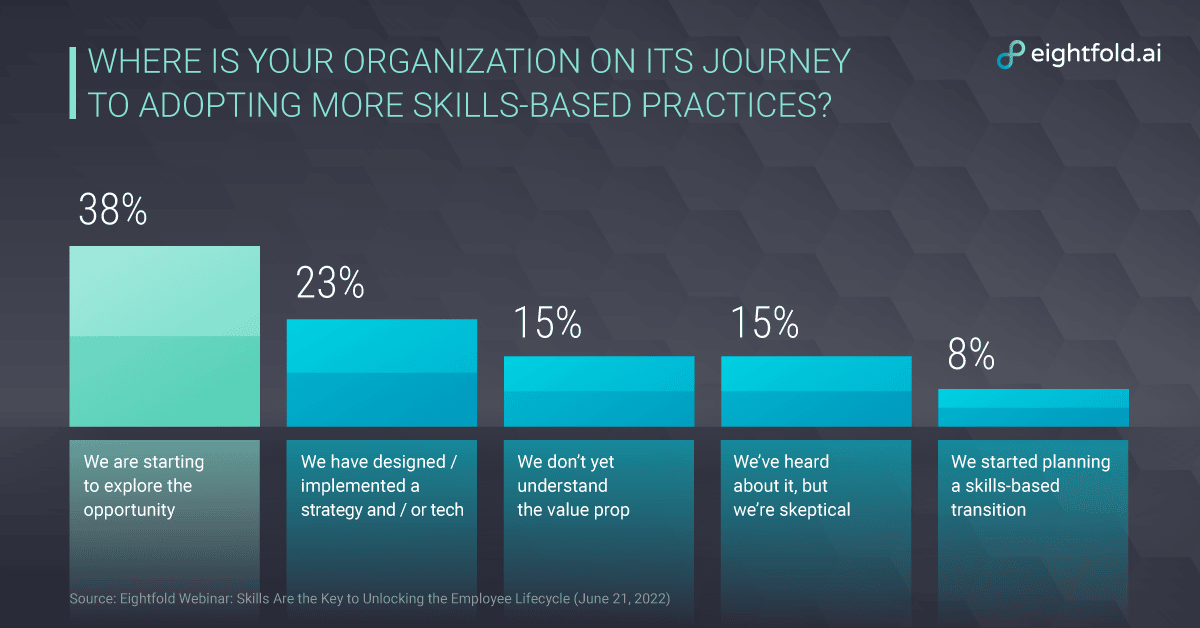The war to fill skills gaps is the top force impacting talent strategies today.
That is according to the majority of HR leaders who responded to a poll conducted during our recent webinar on skills.
75% of HR professionals said the war to fill skill gaps is having the greatest impact on their talent strategy today.
Filling skills gaps as a top challenge comes as no surprise in this uncertain labor market—and HR leaders know there is value in skills-based talent processes.
In our 2022 Talent Survey, one in two HR leaders said having the right skills to perform a job was critical. The shift from hiring for roles to understanding a candidate’s full potential, aptitude, and adjacent skills is the new norm. This helps any organization attract highly qualified talent and be confident that those people can learn new skills and build long-term careers within their organization.
“People are more than their roles,” said Jason Cerrato, Senior Director, Product Marketing at Eightfold AI. “And they need a more comprehensive talent profile so an organization can understand all the skills they can bring to the table.”
In the webinar, Carly Ackerman, Director of Customer Experience at Eightfold AI, and Craig Powers, SAPInsider Research Analyst, joined Cerrato to discuss the most pressing internal and external forces impacting talent strategies today. They also mapped out actions for winning the skills war.
“We’re seeing two buckets of forces affecting an organization’s ability to develop skills,” Ackerman said. “First, internal forces leading organizations need to change how they operate and upend the way leaders lead. And external forces are leading organizations to reevaluate purpose and business priorities.”
As with everything in this uncertain world, these forces are expected to shift with priorities, the economy playing the biggest role in affecting outcomes. Ackerman said it’s this duality of internal and external forces that will pressure organizations into changing how they approach talent strategies.
The top three internal forces impacting skills development
Internal forces are something an organization can somewhat foresee and control within reason.
Increased organizational complexity is making a big impact on how they can identify and use skills to their best advantages. Today, workforces rely much more on contingent workers, hybrid workforces, and even fully remote workforce designs. Yet they’ve done little to prepare their leaders to support and manage these different work environments.
“We’ve arrived at a point on the future-of-work continuum, and it’s not just upskilling but weathering an entire revolution of an industry, like core banking moving to cryptocurrency,” Ackerman said. “These are fundamental shifts in the business model that need to be addressed.”
There’s also a power shift between employers and employees spurred by the pandemic. Employees now have more leverage as leaders work to retain talent while also searching for new people to fill in the gaps.
Finally, the role of leaders has greatly expanded. Their roles have evolved and so has the scope of their work. They are expected to have more skills than ever.
And many skills listed on job descriptions today are already outdated. It’s anticipated that more than 40 percent of leadership roles will be significantly different by 2025, according to a 2022 Workplace Learning Report from LinkedIn.
Josh Bersin’s research on “T-shaped careers” also reflects this trend, in which he says leaders will have to do more to provide even more value to their organizations.
But this is one area where tech can help.
“Looking into the future at skills coming down the pipe is mind-bending,” Ackerman said. “It’s the ‘crystal ball’ idea. You used to have to have some magic to look into the future; it’s amazing to see the technology advance as quickly as it has to do predictive modeling to understand what skills will be needed. You can think about skills you can build early on to develop a leadership trajectory. You can now do that.
“We’ve moved out of the realm of magic and into reality.”

The top three external forces impacting skills development
External forces—like pandemics, natural disasters, political conflict, and wars—organizations have no control over.
Workers are seeing their jobs in a new light. Organizations are often viewed as a social safety net in the wake of political, social, or economic upheaval.
Employees want to feel like they can trust their employers and leaders for their well-being.
“One thing we noticed is that companies more satisfied with their HR tech and strategies are much more likely to promote increased employee satisfaction through employee experiences,” Ackerman said. “Employee satisfaction needs to be a core requirement of your strategy.”
The war on talent is more aggressive than ever. Employees who don’t feel like their skills are being put to good use in their current roles are 10 times more likely to look for a new job than those who feel their skills are necessary.
Additionally, employee burnout continues to be an immense issue. Organizations need effective strategies for managing burnout, or risk losing their people.
A skills-based approach to career paths and internal movement can help remove ambiguity and increase transparency, helping employees better understand possible career paths and opportunities.
It also has the potential to drive engagement and retention and guide employees toward relevant training and resources that map to where they are trying to go, so they don’t feel like they’re spinning their wheels.
The last external force is a big one—how an organization responds to and manages a crisis. Crisis response is tied to the idea of employees perceiving their organization as a social safety net. Workers want to know that their organization can handle a crisis efficiently and effectively.
How an organization responds to a crisis can change brand perception and employment brand perspective. The right—or wrong—messages can change the candidate pool, too.
“When it comes to crisis response, it’s about delivering on your promises,” Ackerman said. “If you deliver, employees will trust you more.”

Five actions to unlock workforce potential
Internal and external forces are causing more pressure at every level. Learning how to unlock organizational ability to maximize skills is one of the best ways to ease those pressures.
Here are five ways to unlock the skills potential in any organization.
1. Make skills understandable and actionable. Shifting to a skills-based system is a huge change for HR and the workforce—many think implementing a new tool or solution will solve the problem alone, but that isn’t enough.
This is change management for both HR teams and employees. Everyone needs to be bought-in and understand the value of a skills-focused approach. Employees need to see their skills-related data, have skills show up in their daily work, and understand how it ties to value delivery.
2. Skills have to be owned across the organization. It is important that the business is involved to stay competitive in the market. To weather an entire industry change, organizations need to understand what skills are already in-house and what needs to evolve. Find the business champions, demonstrate success in pockets, and scale from there.
3. Skills can be currency to match people with internal opportunities. With AI-powered tools, it’s easier to enable internal mobility than look for external opportunities.
Building a culture of internal mobility is essential. Leaders can be tempted to hoard their talent, but that doesn’t serve anyone in the long run. Incentive structures should encourage leaders to let their people grow and develop, and that means letting people go for new opportunities.
“We’re also seeing organizations deconstructing jobs,” Cerrato said. “They’re thinking if I can’t find someone who has these 15 skills, maybe I can deploy a project team and each person can do three or four things. It’s better to assemble a project team to address skills gaps than take multiple months to find one person to do it.”
4. Democratize skills, work, and opportunities, enabling a culture of continuous learning. Closely related to increased internal mobility is the talent marketplace. Workers need a place where they can find everything: internal postings, business resource groups, learning courses, mentors, and skill-building opportunities.
By exposing workers to these types of opportunities based upon the skills they have and their potential to grow, organizations are providing them with ownership and agency over their career paths.
5. Embed skills across every point of the talent lifecycle. Skills will become the fabric of any organization that ties everything together—work, culture, and values. Skills add transparency at every point in an employee’s career journey, removing barriers that might stymie promising talent.
Overall, a more dynamic approach to building skills moves any organization from a reactive to a predictive talent-management strategy. And in this new uncertain world of work, that is a solid plan for staying ahead in any industry.
This article is based on the webinar “Skills are the Key to Unlocking the Employee Lifecycle” Watch it now to learn more about how building a skills-focused organization will strengthen your talent strategy.



